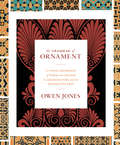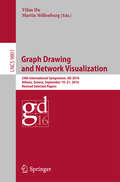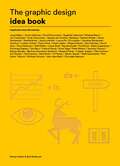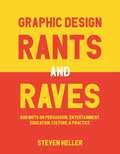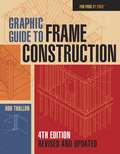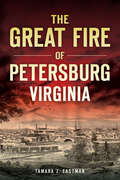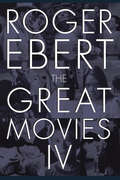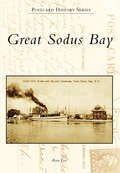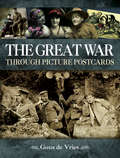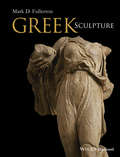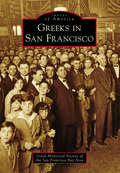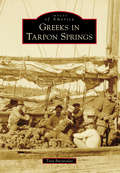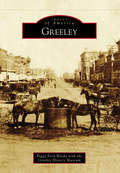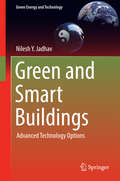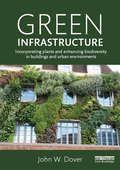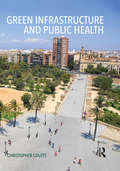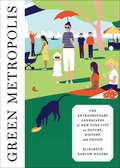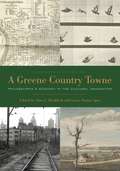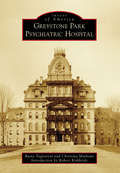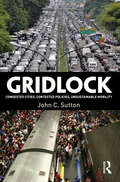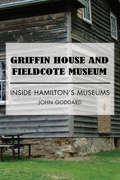- Table View
- List View
The Grammar of Ornament: A Visual Reference of Form and Colour in Architecture and the Decorative Arts
by Owen JonesThe complete and unabridged full-color editionFirst published in 1856, The Grammar of Ornament remains a design classic. Its inspiration came from pioneering British architect and designer Owen Jones (1809-1874), who produced a comprehensive design treatise for the machine age, lavishly illustrated in vivid chromolithographic color. Jones made detailed observations of decorative arts on his travels in Europe, the Middle East, and in his native London, where he studied objects on display at the Great Exhibition of the Works of Industry of All Nations in 1851 and at local museums. His aim was to improve the quality of Western design by changing the habits of Victorian designers, who indiscriminately mixed elements from a wide variety of sources.Jones's resulting study is a comprehensive analysis of styles of ornamental design, presenting key examples ranging from Maori tattoos, Egyptian columns, and Greek borders to Byzantine mosaic, Indian embroidery, and Elizabethan carvings. At once splendidly Victorian and insistently modern, The Grammar of Ornament celebrates objects of beauty from across time periods and continents, and remains an indispensable sourcebook today.
Graph Drawing and Network Visualization
by Yifan Hu Martin NöllenburgThis book constitutes revised selected papers from the 24th International Symposium on Graph Drawing and Network Visualization, GD 2016, held in Athens, Greece, in September 2016. The 45 papers presented in this volume were carefully reviewed and selected from 99 submissions. They were organized in topical sections named: large graphs and clutter avoidance; clustered graphs; planar graphs, layered and tree drawings; visibility representations; beyond planarity; crossing minimization and crossing numbers; topological graph theory; special graph embeddings; dynamic graphs, contest report.
The Graphic Design Idea Book
by Gaile AndersonThis book serves as an introduction to the key elements of good design.Broken into sections covering the fundamental elements of design, key works by acclaimed designers serve to illustrate technical points and encourage readers to try out new ideas. Themes covered include narrative, colour, illusion, ornament, simplicity, and wit and humour.The result is an instantly accessible and easy to understand guide to graphic design using professional techniques.
The Graphic Design Idea Book: Inspiration from 50 Masters
by Gail Anderson Gaile Anderson Steven HellerThis book serves as an introduction to the key elements of good design.Broken into sections covering the fundamental elements of design, key works by acclaimed designers serve to illustrate technical points and encourage readers to try out new ideas. Themes covered include narrative, colour, illusion, ornament, simplicity, and wit and humour.The result is an instantly accessible and easy to understand guide to graphic design using professional techniques.
Graphic Design Rants and Raves: Bon Mots on Persuasion, Entertainment, Education, Culture, and Practice
by Steven HellerDesign is everywhere. Graphic design enters into everything. This is the scope of designer Steven Heller's latest essay anthology that covers the spectrum of graphic design and related art and culture. Looking at design as practice, language, culture, and power, each of the forty-plus essays is a self-contained story. Heller pours out his ideas-criticisms and celebrations-on such topics as:A history of our modern Hindu-Arabic numerals, and a look at the letter KBrand design utilized by Hillary Clinton and Donald Trump early in the 2016 Presidential raceThe tumultuous relationship between design and sexThe Charlie Hebdo massacre and the principles of free expressionIcons revisited, including Paul Rand (not to be confused with the politician Rand Paul), Ralph Ginzburg, Frank Zachary, George Lois, and Print magazineFood packaging, the design of milk, and USPS stampsThe obsessive use of cuteness, and the sad and happy history of the ubiquitous happy face From commercial advertising to government institutions to cultural revolution, from the objects that push design forward to those that seep into the everyday, Graphic Design Rants and Raves is an exploration of how visual design has arrived in the twenty-first century.Allworth Press, an imprint of Skyhorse Publishing, publishes a broad range of books on the visual and performing arts, with emphasis on the business of art. Our titles cover subjects such as graphic design, theater, branding, fine art, photography, interior design, writing, acting, film, how to start careers, business and legal forms, business practices, and more. While we don't aspire to publish a New York Times bestseller or a national bestseller, we are deeply committed to quality books that help creative professionals succeed and thrive. We often publish in areas overlooked by other publishers and welcome the author whose expertise can help our audience of readers.
Graphic Guide To Frame Construction: Details For Builders And Designers (For Pros By Pros Ser.)
by Robert ThallonIf you're in need of info on framing construction, look no further. This newly revised and updated edition of our classic visual handbook is loaded with up-to-date code information, the latest material advice, and detailed construction methods. Building on the success of earlier editions--which have sold hundreds of thousands of copies--accomplished architect and teacher Rob Thallon delivers on the details you need to get the job done right.<p><p> Covers a broad range of projects. Whether you're setting a foundation, erecting a partition wall, or flashing a window, you'll find information on the project in this book. The book's major categories include:<p><p> Footings and Foundations Beams, Joist Systems, and Subflooring Wall Framing, Bracing, and Sheathing Roof Framing, Flashing, and Insulation Exterior and Interior Stairs and Handrails<p><p>
The Great Fire of Petersburg, Virginia (Disaster)
by Tamara J. EastmanOn July 16, 1815, a fire began in a small stable in Petersburg. After only a few hours, almost two-thirds of the city lay in ruins. Citizens stood on the banks of the Appomattox River and watched as wind blew flames from one building to the next. The tragedy claimed a dozen lives and destroyed more than five hundred homes. The fire raged until it was quelled by a downpour of rain. Stories of heroism from firefighters and landowners were left in the aftermath. Author Tamara Eastman describes the city before the fire, the horrific event and the collective efforts to rebuild a stronger city.
The Great Movies IV
by Roger Ebert Matt Zoller Seitz Chaz EbertNo film critic has ever been as influential--or as beloved-- as Roger Ebert. Over more than four decades, he built a reputation writing reviews for the Chicago Sun-Times and, later, arguing onscreen with rival Chicago Tribune critic Gene Siskel and later Richard Roeper about the movies they loved and loathed. But Ebert went well beyond a mere "thumbs up" or "thumbs down." Readers could always sense the man behind the words, a man with interests beyond film and a lifetime's distilled wisdom about the larger world. Although the world lost one of its most important critics far too early, Ebert lives on in the minds of moviegoers today, who continually find themselves debating what he might have thought about a current movie. The Great Movies IV is the fourth--and final--collection of Roger Ebert's essays, comprising sixty-two reviews of films ranging from the silent era to the recent past. From films like The Cabinet of Caligari and Viridiana that have been considered canonical for decades to movies only recently recognized as masterpieces to Superman, The Big Lebowski, and Pink Floyd: The Wall, the pieces gathered here demonstrate the critical acumen seen in Ebert's daily reviews and the more reflective and wide-ranging considerations that the longer format allowed him to offer. Ebert's essays are joined here by an insightful foreword by film critic Matt Zoller Seitz, the current editor-in-chief of the official Roger Ebert website, and a touching introduction by Chaz Ebert. A fitting capstone to a truly remarkable career, The Great Movies IV will introduce newcomers to some of the most exceptional movies ever made, while revealing new insights to connoisseurs as well.
Great Sodus Bay (Postcard History)
by Rosa FoxGreat Sodus Bay graces the southern shore of Lake Ontario. Known as Bay of the Cayugas to early French explorers and Assorodus (Silvery Waters) to Native American Indians, Sodus Bay is bountiful in beauty and history. Host to many creative souls, entrepreneurs, and seekers of nature, relaxation, and recreation, Great Sodus Bay has captured the hearts of all who visit. The images in this volume provide a tour of the communities and commercial developments, as well as historic lighthouses, vintage boats, and architecture. Take a nostalgic look at Great Sodus Bay from 1890 to 1930--an era of newfound popularity as Sodus Bay developed into a destination resort.
The Great War Through Picture Postcards
by Guus de VriesDuring World War I, the picture postcard was the most important means of communication for the soldiers in the field and their loved ones at home, with an estimated 30 billion of them sent between 1914 and 1918. A Postcard from home offered the soldier in the trenches a short escape from their daily hell, while receiving a postcard from the man on the front-line was literally a sign of life. These postcards create a vivid record of life at home and abroad during the Great War, both from the messages they carries and the pictures on the cards themselves. The dipiction of war on the contemporary postcards is extremely diverse: The ways in which the postcards depict the war differs greatly; from simple enthusiasm, patriotism and propaganda to humour, satire and bitter hatred. Other portray the wishes and dreams (nostalgia, homesickness and pin-ups) of the soldiers, the technological developments of the armies, not to mention the daily life and death on the battlefield, including the horrific reality of piles of bodied and mass-graves Altogether, this extraordinarily vivid contemporary record of the Great War offers a unique and details insight on the minds and mentality of the soldiers and their families who lived and died in the war to end all wars.
The Great White Shark Scientist (Scientists in the Field Series)
by Sy Montgomery Keith Ellenbogen<P>Dr. Greg Skomal, biologist and head of the Massachusetts Shark Research Program, is investigating a controversial possibility: Might Cape Cod's waters serve as a breeding ground for the great white shark, the largest and most feared predatory fish on Earth? <P>Sy Montgomery and Keith Ellenbogen report on this thrilling turning point in marine research and travel to Guadeloupe, Mexico, to get up close and personal with the sharks. This daring expedition into the realm of great whites shows readers that in order to save the planet and its creatures, we must embrace our humanity and face our greatest fears. <P><b>Winner of the 2018 Riverby Award</b>
Greek Culture in the Roman World: Greek Myths in Roman Art and Culture
by Zahra NewbyImages of episodes from Greek mythology are widespread in Roman art, appearing in sculptural groups, mosaics, paintings and reliefs. They attest to Rome's enduring fascination with Greek culture, and its desire to absorb and reframe that culture for new ends. This book provides a comprehensive account of the meanings of Greek myth across the spectrum of Roman art, including public, domestic and funerary contexts. It argues that myths, in addition to functioning as signifiers of a patron's education or paideia, played an important role as rhetorical and didactic exempla. The changing use of mythological imagery in domestic and funerary art in particular reveals an important shift in Roman values and senses of identity across the period of the first two centuries AD, and in the ways that Greek culture was turned to serve Roman values.
Greek Sculpture
by Mark D. FullertonGreek Sculpture presents a chronological overview of the plastic and glyptic art forms in the ancient Greek world from the emergence of life-sized marble statuary at the end of the seventh century BC to the appropriation of Greek sculptural traditions by Rome in the first two centuries AD. Compares the evolution of Greek sculpture over the centuries to works of contemporaneous Mediterranean civilizations Emphasizes looking closely at the stylistic features of Greek sculpture, illustrating these observations where possible with original works rather than copies Places the remarkable progress of stylistic changes that took place in Greek sculpture within a broader social and historical context Facilitates an understanding of why Greek monuments look the way they do and what ideas they were capable of expressing Focuses on the most recent interpretations of Greek sculptural works while considering the fragile and fragmentary evidence uncovered
Greeks in San Francisco (Images of America)
by Greek Historical Society of the San Francisco BayThe history of San Francisco's Greek community is linked to the history of San Francisco. The first Greeks to arrive were sailors, miners, and laborers. By the 1880s, they had formed benevolent, civic, and fraternal organizations. In 1904, the first Greek Orthodox Church west of Chicago was established, and Third Street became the heart of the Greek community. The 1906 earthquake and fire destroyed much of their new community, but undaunted, the Greeks of San Francisco rebuilt their lives to become business leaders and politicians, contributing their entrepreneurial and philanthropic spirit to the city's rich heritage.
Greeks in Tarpon Springs (Images of America)
by Tina BucuvalasBeginning in 1905, large numbers of Greeks from the Dodecanese and Saronic Gulf islands settled in Tarpon Springs to work in the sponge business. They significantly expanded the industry and changed Tarpon Springs forever. Greektown flourished with residences, stores, churches, restaurants, and recreational facilities stretching from the sponge docks to downtown. Sponge fishing and related activities served as the economic base for the community. By 1913, as many as half of Tarpon Springs residents were reputedly Greek, and many businesses displayed both Greek and American flags. Today, Tarpon Springs' Greek community preserves a strong ethnic and maritime heritage. While some major US cities have a larger Greek population, no other has a greater percentage with Greek heritage than Tarpon Springs.
Greeley (Images of America)
by Greeley History Museum Peggy Ford WaldoIn October 1869, Nathan Meeker, the New York Tribune's agricultural editor, visited the Colorado Territory. Impressed with the scenery, people, climate, and resources, he wrote an article, "A Western Colony," for the Tribune, inviting principled people with money to invest in a temperance and agricultural colony. Over 3,000 prospective colonists wrote to Meeker. On December 23, Meeker founded the Union Colony, a joint-stock colonization company, and chose 737 of the best applicants as members. In April 1870, the company established the town of Greeley, named for Tribune editor Horace Greeley. Founded on the principles of temperance, religion, education, agriculture, irrigation, cooperation, and family values, Greeley became the Weld County seat in 1877. Agriculture and water development ensured Greeley's reputation as the "Garden Spot of the State." Potatoes became its first commercially viable crop. From 1900 to 1950, agricultural expansion ushered in a succession of immigrants, including Germans from Russia, Japanese, Hispanics, and Mexican nationals, looking for work and new opportunities. Greeley's economy, growth, and diversity remain rooted in the land and its people.
Green and Smart Buildings
by Nilesh Y. JadhavThis book highlights the various technologies that are currently available or are now being developed for the green and smart buildings of the future. It examines why green building performance is important, and how it can be measured and rated using appropriate benchmarking systems. Lastly, the book provides an overview of the state-of-the-art in green building technologies and the trend towards zero energy or net positive energy buildings in the future.
Green Infrastructure: Incorporating Plants and Enhancing Biodiversity in Buildings and Urban Environments (Routledge Studies in Urban Ecology)
by John W. DoverWith more than half of the world's population now living in urban areas, it is vitally important that towns and cities are healthy places to live. The principal aim of this book is to synthesize the disparate literature on the use of vegetation in the built environment and its multifunctional benefits to humans. The author reviews issues such as: contact with wildlife and its immediate and long-term effects on psychological and physical wellbeing; the role of vegetation in removing health-damaging pollutants from the air; green roofs and green walls, which provide insulation, reduce energy use and decrease the carbon footprint of buildings; and structural vegetation such as street trees, providing shading and air circulation whilst also helping to stop flash-floods through surface drainage. Examples are used throughout to illustrate the practical use of vegetation to improve the urban environment and deliver ecosystem services. Whilst the underlying theme is the value of biodiversity, the emphasis is less on existing high-value green spaces (such as nature reserves, parks and gardens), than on the sealed surfaces of urban areas (building surfaces, roads, car parks, plazas, etc.). The book shows how these, and the spaces they encapsulate, can be modified to meet current and future environmental challenges including climate change. The value of existing green space is also covered to provide a comprehensive textbook of international relevance.
Green Infrastructure and Public Health
by Christopher CouttsThere is a growing body of knowledge revealing a sweeping array of connections between public health and green infrastructure – but not until now have the links between them been brought together in one comprehensive book. Green Infrastructure and Public Health provides an overview of current research and theories of the ecological relationships and mechanisms by which the environment influences human health and health behaviour. Covering a broad spectrum of contemporary understanding, Coutts outlines: public health models that explicitly promote the importance of the environment to health ways in which the quality of the landscape is tied to health challenges of maintaining viable landscapes amidst a rapidly changing global environment This book presents the case for fundamental human dependence on the natural environment and creates a bridge between contemporary science on the structure and form of a healthy landscape and the myriad ways that a healthy landscape supports healthy human beings. It presents ideal reading for students and practitioners of landscape architecture, urban design, planning, and health studies.
Green Metropolis: The Extraordinary Landscapes of New York City as Nature, History, and Design
by Elizabeth Barlow Rogers Tony HissElizabeth Barlow Rogers, the woman who launched the restoration of Central Park in the 1980s, now introduces us to seven remarkable green spaces in and around New York City, giving us the history--both natural and human--of how they have been transformed over time.Here we find: The greenbelt and nature refuge that runs along the spine of Staten Island on land once intended for a highway, where mushrooms can be gathered and, at the right moment, seventeen-year locusts viewed. Jamaica Bay, near John F. Kennedy International Airport, whose mosaic of fragile, endangered marshes has been preserved as a bird sanctuary on the Atlantic Flyway, full of egrets, terns, and horseshoe crabs. Inwood Hill, in upper Manhattan, whose forest once sheltered Native Americans and Revolutionary soldiers before it became a site for wealthy estates and subsequently a public park. The Central Park Ramble, an artfully designed wilderness in the middle of the city, with native and imported flora, magnificent rock outcrops, and numerous species of resident and migrating birds. Roosevelt Island, formerly Welfare Island, in the East River, where urban planners built a "new town in town" in the 1970s and whose southern tip is the dramatic setting for the Louis Kahn-designed memorial to Franklin Delano Roosevelt. Freshkills, the unusual twenty-two-hundred-acre park on Staten Island that is being created out of what was once the world's largest landfill. The High Line, in Manhattan's Chelsea and West Village neighborhoods, an aerial promenade built on an abandoned elevated rail spur with its native grasses and panoramic views of the Hudson River and the downtown cityscape.Full of the natural history of the parks along with interesting historical facts and interviews with caretakers, guides, local residents, guardians, and visitors, this beautifully illustrated book is a treasure trove of information about the varied and pleasurable green spaces that grace New York City.From the Hardcover edition.
A Greene Country Towne: Philadelphia’s Ecology in the Cultural Imagination
by Alan C. Braddock Laura Turner IgoeAn unconventional history of Philadelphia that operates at the threshold of cultural and environmental studies, A Greene Country Towne expands the meaning of community beyond people to encompass nonhuman beings, things, and forces.By examining a diverse range of cultural acts and material objects created in Philadelphia—from Native American artifacts, early stoves, and literary works to public parks, photographs, and paintings—through the lens of new materialism, the essays in A Greene Country Towne ask us to consider an urban environmental history in which humans are not the only protagonists. This collection reimagines the city as a system of constantly evolving constituents and agencies that have interacted over time, a system powerfully captured by Philadelphia artists, writers, architects, and planners since the seventeenth century. In addition to the editors, contributors to this volume are Maria Farland, Nate Gabriel, Andrea L. M. Hansen, Scott Hicks, Michael Dean Mackintosh, Amy E. Menzer, Stephen Nepa, John Ott, Sue Ann Prince, and Mary I. Unger.
A Greene Country Towne: Philadelphia’s Ecology in the Cultural Imagination
by Alan C. Braddock Laura Turner IgoeAn unconventional history of Philadelphia that operates at the threshold of cultural and environmental studies, A Greene Country Towne expands the meaning of community beyond people to encompass nonhuman beings, things, and forces.By examining a diverse range of cultural acts and material objects created in Philadelphia—from Native American artifacts, early stoves, and literary works to public parks, photographs, and paintings—through the lens of new materialism, the essays in A Greene Country Towne ask us to consider an urban environmental history in which humans are not the only protagonists. This collection reimagines the city as a system of constantly evolving constituents and agencies that have interacted over time, a system powerfully captured by Philadelphia artists, writers, architects, and planners since the seventeenth century. In addition to the editors, contributors to this volume are Maria Farland, Nate Gabriel, Andrea L. M. Hansen, Scott Hicks, Michael Dean Mackintosh, Amy E. Menzer, Stephen Nepa, John Ott, Sue Ann Prince, and Mary I. Unger.
Greystone Park Psychiatric Hospital (Images of America)
by Christina Mathews Robert Kirkbride Rusty TagliareniThe Greystone Park Psychiatric Hospital was more than a building; it embodied an entire era of uniquely American history, from the unparalleled humanitarian efforts of Dorothea Dix to the revolutionary architectural concepts of Thomas Story Kirkbride. After well over a century of service, Greystone was left abandoned in 2008. From the time it closed until its demolition in 2015, Greystone became the focal point of a passionate preservation effort that drew national attention and served to spark the public's interest in historical asylum preservation. Many of the images contained in this book were rescued from the basement of Greystone in 2002 and have never been seen by the public. They appear courtesy of the Morris Plains Museum and its staff, who spent many hours digitally archiving the photographs so that future generations may better know Greystone's history.
Gridlock: Congested Cities, Contested Policies, Unsustainable Mobility
by John C. SuttonCities across the world are facing unprecedented challenges in traffic management and transit congestion while coping with growing populations and mobility aspirations; existing policies that aim to tackle congestion and create more sustainable transport futures offer only weak remedies. In Gridlock: Congested Cities, Contested Policies, Unsustainable Mobility, transport consultant John C. Sutton explores how two competing discourses in transport policy and planning practice – convivial and competitive ideologies – lead to contradictory solutions and a gridlock in policy as well as on transport systems. Gridlock examines current transport and mobility in a geographical, social, political-economy and technological context. The challenges of rising congestion are highlighted through case studies from the UK, the USA, and OECD countries. Sutton offers readers a vision of a sustainable mobility future through the concept of mobility management, combining mobile communication and information technology with logistics to match travel demand to the capacity of transport systems. Essential reading for transport professionals and students of transportation planning and policy, Gridlock offers a unique manifesto for sustainable mobility settlement, addressing the pressing problems of growing populations and congestion while looking ahead to a more sustainable future.
Griffin House and Fieldcote Museum: Inside Hamilton's Museums
by John GoddardInside Hamilton’s Museums helps to satisfy a growing curiosity about Canada’s steel capital as it evolves into a post-industrial city and cultural destination. In this special excerpt we visit two sites, Griffin House and the Fieldcote Memorial Park and Museum. Griffin House honours one of Ancaster's earliest black settlers, Enerals Griffin, and pays tribute to the black slaves from the United States who fled to freedom in Upper Canada. Fieldcote Museum was built as private home and now functions as a gallery for exhibitions alternating between local history and the visual arts. John Goddard takes us on a detailed tour of the historic homes and gardens, providing fascinating historical background and insight.
